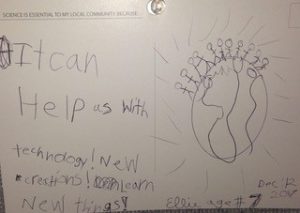December 14, 2017
Science to Action Session Provides Inspiration for Future of Science and Public Engagement
Posted by Timia Crisp
Today’s post is part of a series written by student bloggers from the AGU Fall Meeting.
By: Rebekah Lee, Boise State University
You have probably heard the public calls for more public engagement in science. Many of the issues facing society today are rooted in the geosciences and require public support in order to move toward a solution. Growing populations mean that communities have to produce more with the same amount of resources and a changing climate introduces a great deal of uncertainty for farmers in parts of the world that rely on small producers. In fact, 70 – 80 percent of global food systems depend on small holders. There is a critical need to transfer science research to application of this and many other complex global problems. On Thursday of the AGU 2017 Fall Meeting, a modest group met to discuss how science becomes action.
There was an impressive array of examples in which researchers collaborated with the community to produce positive change. Some involved multiple organizations collaborating in a huge effort reaching millions of people. The Great Shakeout Earthquake Drill spearheaded by the Southern California Earthquake Center was originally intended to be a one-time event. This ‘one time event’ had 5.4 million people participating and was so successful that it continues with participants from all over the U.S. and now Canada.
Other collaborations involved smaller organizations reaching specific communities. For example, in Pakistan researchers engaged “farmer friends” using text messages that informed them when precipitation for the week would provide enough water for their crops or when and how much of flood irrigation would be required. This resulted in a 40% reduction in water usage, critical to a system that was designed for a million people and must now support over 4 million people.
The Community Collaborative Rain, Hail and Snow Network, or COCORAHS, is an example of a grass roots effort to collect precipitation data. Inspired by a deadly flash flood in 1997 in Colorado, COCORAHS is now the largest dataset of precipitation with over 20,000 participants taking daily measurements of rain, hail, snow depth and even snow water content. One of the reasons for its success is due to the ease of the measurements. It takes about five minutes to check gauges and submit a simple form and participants can immediately see their data included in a regional map or table. Furthermore, the data is very reliable thanks to the training that every individual receives.
Another exciting model provided the means of gathering robust public input on NASA’s Asteroid Initiative. Participants were gathered for a full day of thematic sessions that included a short informational video at the beginning followed by peer to peer discussion, Q&A with researchers, group projects and pre- and post- surveys. The recommendations from these public groups were included in a report given to decision makers and provided an additional data point to help inform policy.
Of all of the different models of community engagement, several common lessons emerged. First, there is significant trust in science experts but also a desire for participation in the decisions that affect daily life. This highlights the need to remove the “Ivory Tower” mindset that can alienate the very public we wish to engage. Second, the most effective way to encourage change is to include stakeholders in the process from the planning stages of the research. Communities engage with researchers when they are able to participate in goal setting and collection of data that is immediately relevant to that community. Finally, continuous communication and monitoring of common goals is essential when working across multiple organizations.
The energy I felt in the room was almost palpable. There was recognition of the fact that often times these processes are slow but informative and ultimately worth it. There was acknowledgment also of the lonely road this kind of work seems, but presenters gathered encouragement from each other through the session. I think the feeling can best be captured by a quote from the wrap up of the session:
“What you are seeing in these presentations is a glimpse into the future of science… All of these things start small, and we are small, but [public engagement] is powerful









